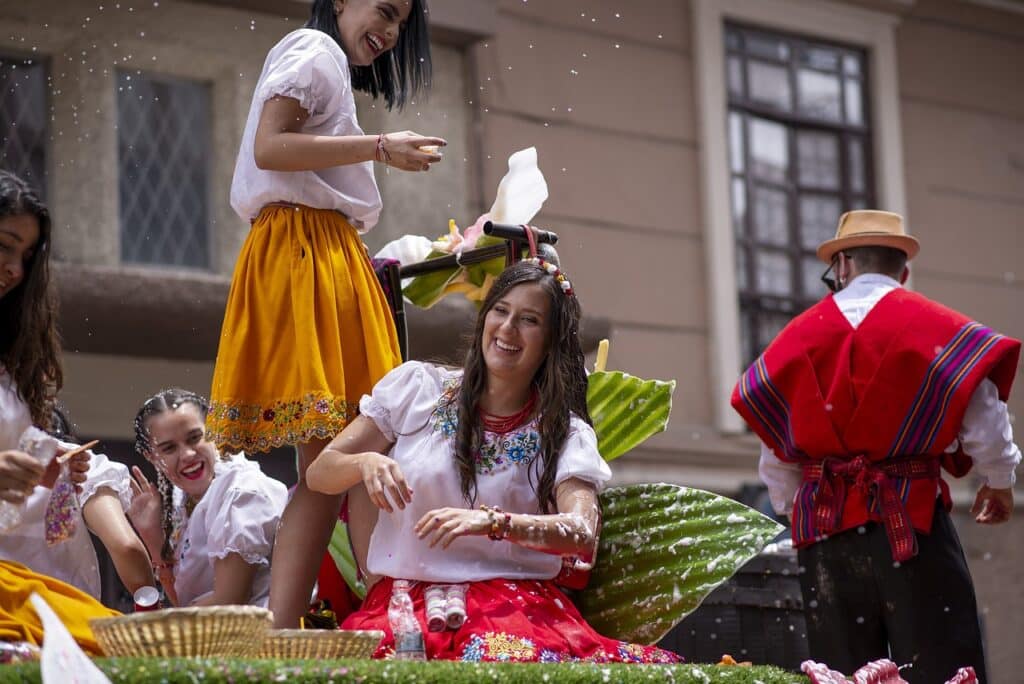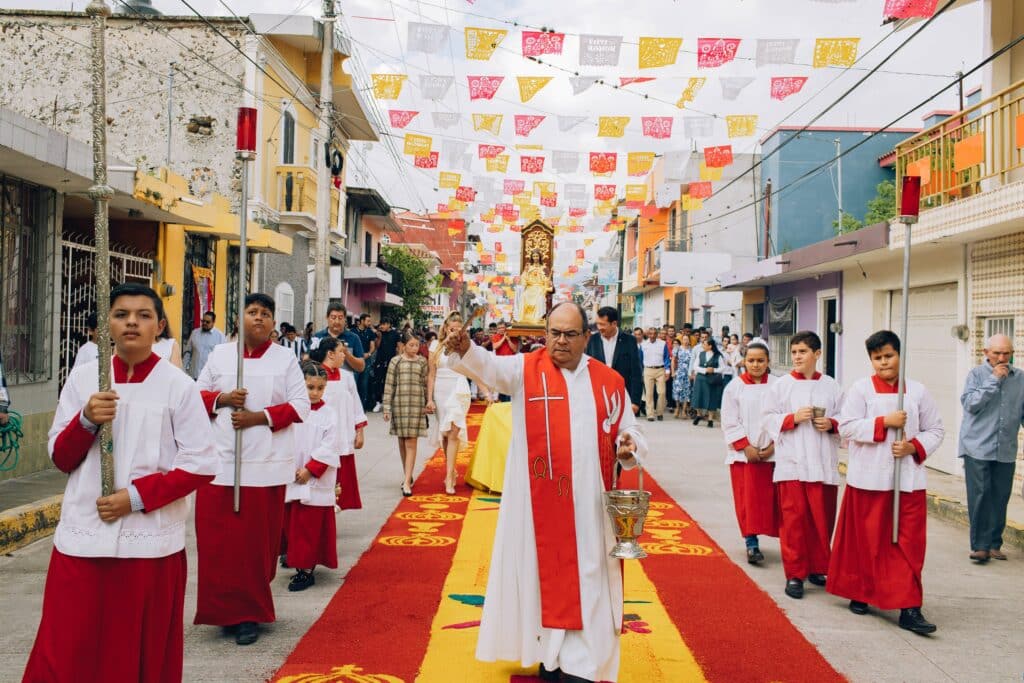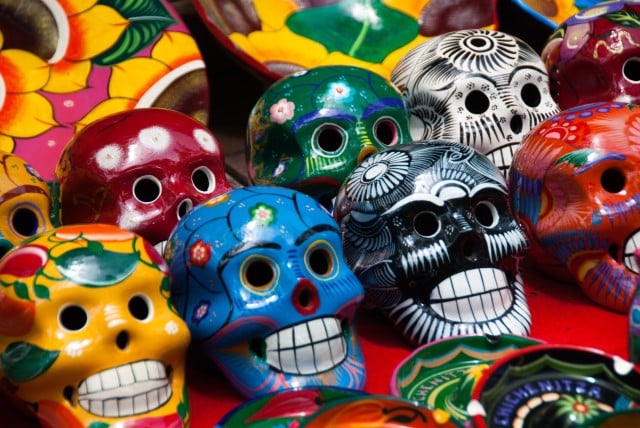Each Latin American country adds a unique flavor to major holidays like Christmas, New Year’s, and Mother’s Day. The nations of Central and South America also have many regional or country-specific holidays to commemorate.
Whether you’re an immigrant who misses home, an expat, or a visitor, these Latin American holiday traditions featured on this list created by our team here at Remitly are worth celebrating. Read on to learn more about them.
Latin American Holidays and How They’re Celebrated
Central and South American holidays are just as varied as the countries that celebrate them. Some are specific to individual countries, while others have a common origin but have evolved in different ways.
With over 30 countries in the region, there are plenty of ways to celebrate throughout the year.
Three Kings Day
Three Kings Day, also known as Día de los Reyes Magos or Epiphany, is a cherished tradition in Latin America, celebrated on January 6th. This holiday commemorates the visit of the three wise men to the baby Jesus in Bethlehem, bearing gifts of gold, frankincense, and myrrh.
In many regions, children leave their shoes out the night before, hoping to receive gifts or sweets from the three kings. Parades and festivities known as “Las Mañanitas” highlight the day, with participants dressed as the wise men, distributing candies and gifts to onlookers.
It’s also common to enjoy a “Rosca de Reyes,” a circular sweet bread adorned with candied fruits, symbolizing a crown. Hidden inside is a small figurine of baby Jesus, and whoever finds it is tasked with hosting a party on February 2nd, known as Día de la Candelaria.
Día de la Altagracía: Dominican Republic
Held on January 21 each year, Día de la Altagracía is a feast day for Our Lady of Altagracia, a painting of the Virgin Mary kept at the Basílica Catedral Nuestra Señora de la Altagracia in Salvaleón de Higüey.
Dominicans see the image as a protector of the Dominican Republic and spend the day paying tribute to it with feasts, dancing, and singing religious songs. To prepare for the day, some people hold candlelight vigils all night on January 20th.
Día de San Blas: Paraguay
Día de San Blas, or Saint Blaise’s Day, is a cherished celebration that takes place on February 3rd in Paraguay. It doesn’t coincide with major global festivities, but it holds significant religious importance. The day is dedicated to Saint Blaise, the patron saint of throat illnesses, who is revered for his healing powers.
In Paraguay, it’s customary for people to attend church services where priests bless the throats of the attendees, invoking protection against ailments. Traditional Paraguayan businesses often close or have reduced hours to allow employees to partake in these religious ceremonies. In many communities, vibrant processions, banquets, and folk dances are organized.

Carnaval: South America and the Caribbean
Carnaval, a vibrant and exuberant celebration, pulses through the streets of many Latin American countries in the days leading up to Ash Wednesday. Typically falling in late February or early March, this festivity is rooted in Catholic traditions.
In Brazil’s Rio de Janeiro, the Sambódromo is alive with energy. Samba schools parade with intricate floats, dazzling costumes, and electrifying dances.
Salvador, another key player in Brazil’s Carnaval scene, offers a blend of Afro-Brazilian rhythms. The streets resonate with the beats of drums and the melodies of traditional “afoxé” music.
Colombia’s Barranquilla Carnaval boasts its own unique charm, highlighted by folkloric dances like “Cumbia” and “Mapalé”. In Bolivia, the Oruro Carnaval stands apart with a procession that merges indigenous and religious symbols, dedicated to the Virgin of the Socavón.
In the Dominican Republic, the city of La Vega becomes a hub of activity with its vibrant “Diablos Cojuelos” or “Limping Devils”, mischievous characters dressed in ornate costumes who playfully “whip” onlookers, symbolizing the purification of sins.
Meanwhile, Puerto Rico’s Carnaval de Ponce is marked by traditional “Vejigante” masks, representing the battle between good and evil, with music and dance infusing the celebrations.
Día del Mar: Bolivia
Day of the Sea, referred to as Día del Mar in Spanish, is a poignant remembrance in Bolivia, a landlocked nation longing for its lost coastline.
Observed annually on March 23rd, this day marks the memory of Bolivia’s defeat in the War of the Pacific (1879-1884) and the consequent loss of its coastal territories to Chile. Despite being separated from the sea for over a century, Bolivia’s yearning for its coastline remains deeply entrenched in its national identity.
In La Paz, Bolivia’s administrative capital, schools and public institutions hold solemn ceremonies, with students often dressing in navy uniforms to pay tribute. The central event takes place at the Plaza Abaroa, where speeches and performances recount the historical significance of the day.
Additionally, many Bolivians visit the coastal town of Antofagasta in Chile, once a part of Bolivia, to symbolically reclaim their lost connection to the Pacific.
The day serves not only as a remembrance of loss but also as a reflection of the Bolivian spirit of resilience and hope for a harmonious future.

Holy Week
Holy Week, known as Semana Santa in Spanish, holds a profound spiritual significance throughout Latin America, observed from Mexico to Argentina, Chile to Puerto Rico.
Taking place annually between Palm Sunday and Easter Sunday, typically in late March to early April, this week-long commemoration of the passion, crucifixion, and resurrection of Jesus Christ is marked with deep reverence, rooted in the region’s Christian traditions.
In Antigua, Guatemala, cobblestone streets are adorned with colorful “alfombras” or carpets made from dyed sawdust, flowers, and fruits, laid out in intricate designs, only to be walked over by religious processions.
Mexico’s Iztapalapa district sees a dramatic reenactment of the Stations of the Cross, drawing thousands of spectators each year. In Peru, the Lord of the Miracles, a revered image of Christ, is paraded around Lima, while in Colombia, the town of Popayán is renowned for its solemn nighttime processions.
The exact dates of Semana Santa vary with the liturgical calendar, but whether through silent vigils or vibrant street events, the commitment to tradition and spirituality remains a constant across the continent.
Día del Trabajador
Also referred to as Día del Trabajo, this day is the equivalent of the American observance of Labor Day, and it is one of the Latino holidays celebrated by most Spanish-speaking countries in the Western Hemisphere.
Instead of honoring workers’ contributions on the first Monday in September, Central and Latin American countries celebrate Labor Day on May 1. Many people receive a paid day off, and parades and parties occur in villages, towns, and cities throughout Latin America.
Battle of Puebla (Cinco de Mayo)
While Cinco de Mayo has taken on a life of its own in the U.S., at its heart lies the Battle of Puebla on May 5th—a day when the Mexican Army triumphed over the French Empire.
Particularly revered in Puebla, Mexico, this day sees historical reenactments, parades, and local fiestas. The celebrations are quite different than those in the United States, where the holiday is often confused with Mexican Independence Day, which falls on September 16th.
Mother’s Day and Father’s Day
Both Mother’s Day (Día de la Madre) and Father’s Day (Día del Padre) have taken on greater significance in Latin America recently and are widely celebrated from Argentina to Costa Rica, Guatemala to Uruguay.
In much of Latin America, Día De Las Padres takes place on the same day as most other countries (the third Sunday in June). In Brazil, however, Día dos Pais falls on the second Sunday of August.
In the Dominican Republic, Día de las Madres takes place on the last Sunday in May. In Mexico, the date stays the same from year to year—May 10th.
Dia dos Namorados: Brazil
Many countries in Central and South America celebrate St. Valentine’s Day, but Brazil’s Dia dos Namorados stands out for a few reasons. Instead of falling on February 14th, it occurs on June 12th, St. Anthony’s Day Eve.
This day is closely linked to St. Anthony. Single women, in particular, celebrate with customary activities known as simpatias. These traditions may include putting a love letter in a pot of basil or a rose in a glass of water.
Will it bring love? Who knows, but it may be worth a try!
San Martín Day: Argentina
On the third Monday in August, Argentinians celebrate San Martín Day. The day remembers the death of Argentina’s founding father, José Francisco de San Martin. Serving as a general in the Argentine Army, he helped liberate Argentina from Spain and then went on to aid other colonies in the region in ending Spanish rule.
In honor of San Martin, the Argentine military holds a large parade and then performs a military reenactment at the Mounted Grenadier Regiment in Buenos Aires.
Independence Day on September 15th: Central America
Many Central American countries observe Independence Day on September 15th.
This date honors the Act of Independence for Central America, which was signed by the leaders of Costa Rica, Guatemala, Honduras, Nicaragua, and El Salvador, and it’s not just the date that ties this Latin American holiday together. All five nations participate in a torch relay over several days leading up to September 15th. Along the way, you’ll encounter food, music, and parades.
Mexico also celebrates its independence from Spain around this time. It falls a day later, on September 16th, and is not to be confused with Cinco de Mayo.
Chile’s Fiestas Patrias
Chile sets aside two days, September 18th and 19th, to commemorate its road to independence with the Fiestas Patrias. The festivities are an infusion of parades, traditional rodeos, vibrant dance, and mouthwatering foods.
Whether you’re mingling in a fonda (traditional tent) or witnessing the iconic rodeo events, you’re experiencing the heart and soul of Chilean culture.
Día de La Raza
Día de La Raza occurs on the third Monday in October in several Latin American countries, including Argentina, Chile, Ecuador, Honduras, Mexico, Uruguay, and Venezuela. The day’s purpose is to celebrate indigenous people’s heritage and their contributions to Hispanic culture.
To celebrate the day, people throw large fiestas. In some cities and towns, people parade through the streets wearing traditional costumes, or traditional dance performances are held, and traditional meals are shared.
Grito de Yara: Cuba
Cuba celebrates its independence with Grito de Yara on October 10th. Also called the Día de la Independencia, the day marks the beginning of the war with Spain that ultimately freed the island nation.
Cubans spend Independence Day watching parades and attending concerts. At night, many towns and cities hold stunning fireworks displays.
Día del Soldado: Honduras
In Honduras, October 24th is Día del Soldado or Honduran Army Day. It is a time to thank the soldiers currently serving in the Honduran Armed Forces and to remember those who gave their lives in military conflicts.
Every year, a large military parade takes place in Tegucigalpa, and many people travel to the capital city to watch it. Many smaller cities and villages also hold parades and festivals to mark the occasion.
Día de los Muertos: Mexico
Día de los Muertos, or Day of the Dead, is an autumn holiday celebrated on November 1st and 2nd, but it’s not a somber occasion as the name might suggest. Rather, this Mexican holiday is a vibrant and colorful tribute to deceased loved ones.
Originating from ancient Mesoamerican traditions, it has been integrated with Catholic observances of All Saints’ Day and All Souls’ Day.
Throughout Mexico, families create ofrendas (altars) adorned with marigold flowers, candles, food, and photographs to honor the deceased. Grave sites are visited, cleaned, and decorated, while families gather to share stories, sing, and even dance. Traditional foods, such as pan de muerto (bread of the dead) and sugar skulls, are prepared and consumed.
El Mes de la Patria: Panama
Instead of celebrating their independence with a single holiday, Panamanians have El Mes de la Patria, a full month of holidays in November. They include:
- November 3rd, Separation Day: Remembering when Panama gained full independence by separating from Gran Colombia
- November 4th, Flag Day: A day for honoring and flying the Panamanian flag
- November 5, Colon Day: Honoring Christopher Columbus’ arrival in the New World
- November 10, Primer Grito de Independencia de la Villa de los Santos: Celebrating the start of the independence movement in Panama
- November 28, Independence Day: Commemorating when Panama became free of Spanish rule and joined Gran Colombia
Fiestas de Quito: Ecuador
In the first week of December, Quito, the capital of Ecuador, comes alive with jubilation to honor its founding. Streets are lined with colorful parades, the brave might attend a bullfight, and as the sun sets, parties light up the city.
It’s a week where history and festivity intertwine, offering a unique experience in the heart of the Andes.
La Quema del Diablo: Guatemala
Not celebrated by other Latin American Countries, La Quema del Diablo, or the Burning of the Devil, is unique to Guatemala. At 6 p.m. on December 7, people build bonfires outside of their homes and burn paper effigies of the devil to cleanse away evil spirits.
Then, children crack open piñatas, and everyone enjoys meals consisting of spicy foods. The day marks the official start of the Guatemalan holiday season and can be traced back to the traditions of ancient indigenous people.
Día de las Velitas: Colombia
Día de las Velitas—which means Night of the Little Candles—officially starts the Christmas season in Colombia. It is still a special occasion for many people throughout the country.
Día de las Velitas celebrates the Immaculate Conception of the Virgin Mary on the night of December 7th and into the morning of December 8th. Families place candles outside their homes and along streets to light the path the Virgin Mary will travel.
Día de la Abolición del Ejército: Costa Rica
Día de la Abolición del Ejército, or Army Abolition Day, is a winter holiday that occurs on December 1, but it doesn’t connect to the Christmas season. Instead, the holiday remembers when President José Figueres Ferrer abolished the Costa Rican Armed Forces, ending a civil war on December 1, 1948.
All businesses in Costa Rica are required to offer employees an unpaid day off in remembrance of the day. A televised ceremony is held at the National Museum in San José each year, and many people tune in to watch.
Día de la Virgen de Guadalupe: Mexico
Día de la Virgen de Guadalupe, or the Day of the Virgin of Guadalupe, is a fervent religious celebration in Mexico, honoring the appearance of the Virgin Mary to Juan Diego, an indigenous Mexican, on the hill of Tepeyac in 1531.
Observed annually on December 12th, this day is more than just a religious event; it symbolizes the fusion of indigenous beliefs with Catholicism and serves as a testament to Mexico’s rich cultural and spiritual heritage.
From the heart of Mexico City to the smallest villages, streets burst into life with processions, dances, and songs in homage to the Virgin. Pilgrims from all corners of the country journey to the Basilica of Guadalupe in Mexico City, many walking for days or even performing acts of penance along the way.
Inside the Basilica, the devout gather to catch a glimpse of the revered image of the Virgin, believed to be miraculously imprinted on Juan Diego’s cloak.
Christmas
Christmas, or Navidad, is one of the most recognizable holidays around the world. In Latin America, the Christmas season extends from Las Posadas on December 16th all the way to Día de los Reyes Magos (Epiphany, or the Three Kings Day) on January 6th.
During this time, you’ll see elaborate nativity scenes called nacimientos or pesebres in most Spanish-speaking countries in Central and South America and presepio in Brazil. These are often hand-crafted to reflect the local or regional style.
Most nativity scenes depict Joseph, Mary, and baby Jesus in a Bethlehem manger. Jesus usually isn’t added until midnight on Christmas Eve, known as Noche Buena.
Noche Buena
Many churchgoers in Latin America attend a late supper and mass on Christmas Eve. In some ways, Noche Buena is an even bigger celebration than Christmas Day.
In countries like Guatemala and the Dominican Republic, “bombas” or firecrackers are set off at midnight to kick off the Christmas Day fiesta.
Hanukkah: Argentina
Argentina is home to a Jewish community of about 250,000, making it the largest in Latin America and the sixth-largest in the world. While other Jewish communities in Latin America certainly celebrate Hanukkah, the biggest regional celebrations are in Argentina.
The eight days of Hanukkah are an important time to celebrate the re-dedication of the Second Temple in Jerusalem, which occurred during the second century B.C. Jewish synagogues and communities celebrate this sacred occasion with many festivities.
These include:
- Lighting one candle each day on the menorah
- Reading special sections of the Torah
- Eating special dishes, such as fried foods, that recognize the importance of oil in Jewish culture
- Giving money to children as a way to encourage good behavior and works of charity
New Year’s Eve
New Year’s Eve, known as “Nochevieja” or “Año Nuevo” in many Latin American countries, is celebrated on December 31st, marking the culmination of the year and the anticipation of what’s to come. As midnight approaches, cities, towns, and villages come alive with fireworks, music, and festivities.
Across Latin America, the night is filled with unique traditions and rituals. In many countries, it’s customary to eat 12 grapes at the stroke of midnight, with each grape symbolizing a wish or goal for the coming months. In countries like Brazil, it’s a tradition to wear white clothing for good luck, while in others, suitcases might be taken for a quick walk around the block to symbolize hopes for travel in the upcoming year.
Families and friends gather for feasts, dancing, and to toast the incoming year. Public squares and beaches often host large gatherings where people come together to celebrate with live music, fireworks, and communal joy.
Frequently Asked Questions
Central and South American holidays are just as varied as the countries that celebrate them. Some are specific to individual countries, while others have a common origin but have evolved in different ways. Some notable ones are Three Kings Day, Día de la Altagracía (Dominican Republic), Dia dos Namorados (Brazil), Día de San Blas (Paraguay), Día del Mar (Bolivia), Día del Trabajador, and other ones also known in the English-speaking world like Christmas, Mother’s Day, and Father’s Day.
Argentina is known for having one of the highest numbers of public holidays in Latin America. It typically has around 15 national holidays, along with various regional holidays that can bring the total even higher depending on the province. Some common Argentinian holidays are San Martín Day (Third Monday in August), Independence Day (Día de la Independencia) , Malvinas Day (commemorating the Falklands War), Revolution Day, and Labor Day (Día del Trabajador).
Carnaval, a vibrant celebration, leads up to Lent on Ash Wednesday. Typically falling in late February or early March, this festivity is rooted in Catholic traditions.
Holy Week, known as Semana Santa in Spanish, takes place annually between Palm Sunday and Easter Sunday. This week-long celebration commemorates the passion, crucifixion, and resurrection of Jesus Christ and is rooted in the region’s Christian traditions.
Cinco de Mayo is particularly revered in Puebla, Mexico. This day sees historical reenactments, parades, and local fiestas. The celebrations are quite different than those in the United States, where the holiday is often confused with Mexican Independence Day, which falls on September 16th.
Many Central American countries observe Independence Day on September 15th. This date honors the Act of Independence for Central America, which was signed by the leaders of Costa Rica, Guatemala, Honduras, Nicaragua, and El Salvador. All five nations participate in a torch relay over several days leading up to September 15th. Along the way, you’ll encounter food, music, and parades.
Hispanic Heritage Month is an annual celebration in the United States that recognizes the contributions, culture, and history of Hispanic and Latino Americans. It’s observed from September 15th to October 15th. The dates are significant because they coincide with several important anniversaries in various Latin American countries, such as September 15th (Independence Day for several countries), September 16th (Independence Day for Mexico), and October 12th (Día de la Raza, which celebrates the cultural diversity of Latin America).
Día de los Muertos, or Day of the Dead, is a holiday particularly celebrated in Mexico on November 1st and 2nd. It’s a vibrant and colorful tribute to deceased loved ones. Originating from ancient Mesoamerican traditions, it’s been integrated with Catholic observances of All Saints’ Day and All Souls’ Day. Families create ofrendas (altars) adorned with marigold flowers, candles, food, and photographs to honor the deceased. Grave sites are visited, cleaned, and decorated, while families gather to share stories, sing, and even dance. Traditional foods, such as pan de muerto (bread of the dead) and sugar skulls, are prepared and consumed.

